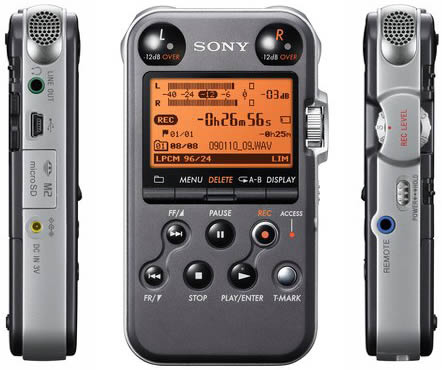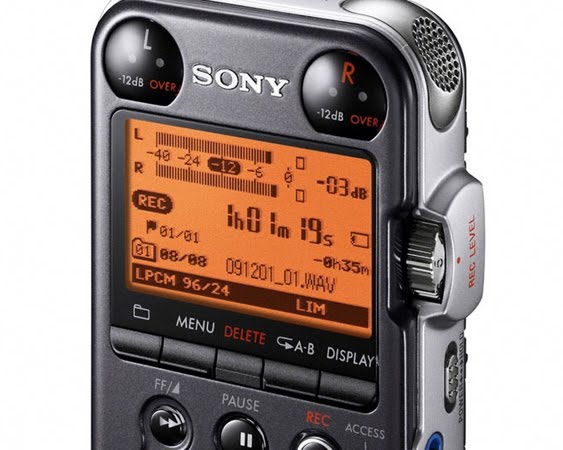Blog
Occasional posts on subjects including field recording, London history and literature, other websites worth looking at, articles in the press, and news of sound-related events.
Building a field recording system 2: the compact recorder
THE COMPACT DIGITAL recorder is a device small enough to stuff into a trouser or jacket pocket. It’s a minor miracle of convenience and versatility compared to bulkier analogue ancestors like the Sony Professional Walkman. Prices have fallen as more manufacturers have entered the contest and current makes include Marantz, Tascam, Roland, Sony, Olympus, Korg and Zoom.
All these recorders are self-contained devices with built-in microphones for recording in stereo. Even basic models can produce uncompressed WAV files at high sample rates, as well as MP3 files. They’ll store the recordings either in a fixed internal memory, or onto removeable SD cards, or both. They’ll also have a USB port so you can easily transfer the recordings to your computer.
The Zoom H1 is the cheapest at around £80. The most expensive is the exotic Korg MR-2 at £550 and I don’t know anyone who’s got one. Both the Zoom H1 and the Korg are outliers which aren’t worth considering. This leaves a range beginning with the Tascam DR-07 at around £120 and extending to the Olympus LS-11 and the Sony PCM M10, both at around £230.
Because the price gap across that range of devices is only just above £100, it really is worth getting either the Sony PCM M10 or the Olympus LS-11. They have better build quality and make cleaner-sounding recordings because they have higher-quality components. You get what you pay for.
Some online comparisons pit the Olympus LS-11 against the Sony PCM M10. By far the best is on Robin Parmar’s Theatre of Noise website. The Sony machine may be a tiny bit better than the Olympus for the field recording system we’re going to build up, so that’s the one that’s going to be looked at here.
CLOSE-UP ON THE SONY PCM M10
As you’d expect from Sony, the build quality is good. The front of the M10 is mostly made of aluminium. The sides and back are plastic. The machine fits quite well into the hand and if you squeeze it you don’t hear nearly so many of the little creaking noises that you get with cheaper recorders.
All the M10’s buttons on the front require a fair amount of pressure to work them, thus reducing the chances of accidentally stopping or starting a recording. The familiar transport buttons of record, play and pause light up from behind to help show what’s going on. The menu system is easy to use, although there are a couple of functions which could do with being brought forward rather than listed inside the ‘detail menu’ option.

The M10 comes with a generous 4-gigabyte internal memory and that’s enough to capture around 3 hours 40 minutes of audio at a decent archival quality setting of 24bit/48kHz. Battery life is superb and you may start to wonder whether the two AAs you put in at the start will ever exhaust themselves. It’s also got a screw fitting on the back so you can mount it on a camera tripod.
AN EYE ON THE LEVELS
Like all compact recorders, the Sony’s backlit display tells you how much time has elapsed, the current filename, the recording mode selected, as well as giving a rough idea of how much battery life is left. One of the more significant parts of the display is the levels meter marked in decibels.
Anyone new to sound recording might reasonably be baffled by the decibel or ‘dB’ markings on the levels meter. If the loudness of normal conversation is reckoned to be around 65dB when heard from a few feet away while virtual silence is 0dB, how can there be such a level as minus 6 or minus 12dB? Why doesn’t the levels meter begin at 0dB and go up to, say, 120dB?
The simplest answer is that although it’s using decibels, the meter’s telling you about audio signal levels inside the machine, which you control, rather than the actual sound pressure levels in the air, which you don’t unless you’re recording yourself singing in the bath.

Decibels are unlike the measurement units we’re most familiar with, such as inches or litres. Each increase of 10dB over some lower value means a ten times increase in the power or intensity of the sound: 20dB is ten times more powerful than 10dB, and 30dB is a hundred times more powerful than 10dB. This is a good way of condensing into manageable units the huge range of differences in sound pressure levels detected by our sense of hearing.
Decibels can also express the differences in the strength of audio signals in an amplifier or other electronic circuit. In the case of the M10’s levels meter, 0db signifies maximum power or gain, and as they grow larger the minus decibel values represent an ever-greater attenuation of gain. Minus 3dB is 50% of maximum gain, minus 6dB is 25%, minus 12dB is 6% and minus 24dB is just 0.4%.
It’s important to get the levels right while recording. The M10 has two coloured lights by each microphone which can help. A green light comes on when the level on that particular channel, left or right, reaches minus 12dB. That’s a desirable level for at least some situations or subjects. A red light comes on when the gain for that channel has reached maximum: time to move away or turn the recording level wheel down a notch or two.
Over time you’ll develop an intuitive feel for how to set your levels depending on where you are and what you’re recording. Don’t ever rely on the M10’s automatic gain control, or indeed that of any other recorder. The results often sound artificial and unattractive. It’s much better to learn about levels through practice.
BUT HOW DOES IT SOUND?
Many reviews of the M10 have praised how quiet or clean its mics sound, meaning they don’t have as much of the hiss and sound colouration that’s noticeable with really cheap kit. Two little mics built into a £230 recorder aren’t going to sound as good as a £450 stereo mic like the Audio Technica BP4025 or a couple of DPA 2006C mics at £1,200 a pair. But they’re not bad and, as stated in the first post in the series, the best recording equipment is always what you’ve got on you at the time.
Here’s a couple of admittedly lazy, opportunistic tests edited together. The first part was made in a lift at work and the second at St Pancras station while waiting for the train home:
The lift recording isn’t particularly useful although there’s no apparent hiss in what was a fairly quiet environment, and the sound of someone jingling keys close by is reasonably well localised. The train station recording is lacking in drama and oomph – in reality people on the platforms at St Pancras often wince at the sharp squealing sounds of the wheels. It’s also hard to work out from the recording in what directions the trains were moving. The M10’s mics produced a poor stereo image in those surroundings.
The Wingfield Audio website has a very useful page of recording samples made with a range of recorders. The M10’s internal mics do well with the isolated, clearly-defined sound sources of a cello and someone talking.
GOING FOR GROWTH: MIC AND LINE INPUTS
One of the goals of the field recording system is to work towards bypassing the recorder’s internal mics and preamplifier in favour of higher-quality external devices made for doing those particular jobs and nothing else. The recorder will then be used for its handy display, analogue-to-digital converter, and file storage only.
On the top of the M10 are the mic and line sockets which will make this possible. It’s a convenient enough place to put them, too.

The bottom of the M10 has a tiny loudspeaker which isn’t useful for much, except perhaps to reassure you that you have actually managed to record something other than silence.
The mic socket is the one on the left in the picture and it has two functions. First, it’s designed to deal with audio signals of mic level strength coming straight from an external microphone and hence relatively weak. The M10’s preamplifier, the same one used to increase the gain of its internal mics, will also increase the gain of a signal reaching it through the mic socket to line level.
The mic socket’s second purpose is to provide plug-in power for any external microphone which needs it. Plug-in power is a low-current supply of around 4 volts and it’s used to drive small microphones called electret condensers or just electrets for short. They’re commonly used as pairs for binaural recording, which we’ll examine in a later post. (The leads from a binaural pair will converge at a single 3.5 mm (1/8”) jack, so you don’t need two mic sockets.)
The line-in socket is a much simpler affair. It can’t provide plug-in power and it’s designed for audio signals which have already been raised by an external preamplifier to line level. A signal reaching the line-in socket therefore bypasses the M10’s preamp because it’s assumed that it doesn’t need to have its gain increased by a large amount.
Yet if you turn the recording level wheel while the M10 is recording an audio source connected to its line-in socket, the levels meter will show the gain increasing or decreasing accordingly. If the M10’s preamp has supposedly been bypassed, what’s causing this to happen? It may be that a different circuit is involved, and if so it’ll be simpler than the preamp because it isn’t designed to increase the gain nearly as much.
This post has touched on technical concepts such as decibels, gain, line level and mic level. It’s useful to have some idea at the outset of what they mean. Next up is a look at the most basic and essential accessories you’ll need to get the best out of your compact recorder.
ABOUT SOUND
FIELD RECORDINGS
The balloonist in the desert is dreaming
The Binaural Diaries of Ollie Hall
GEOGRAPHY AND WANDERINGS
The Ragged Society of Antiquarian Ramblers
LONDON
ORGANISATIONS
Midwest Society for Acoustic Ecology
World Forum for Acoustic Ecology